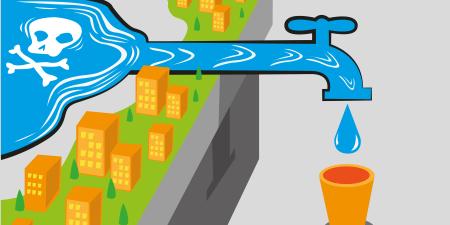The Flint, Michigan, drinking water crisis highlights ethical issues concerning clinicians’ roles in public health, specifically in helping at-risk populations secure safe drinking water. American Medical Association policy (“Lead Contamination in Municipal Water Systems as Exemplified by Flint, Michigan,” H-60.918) addresses the need for specialized care that children exposed to water contamination require. The policy states that the American Medical Association will “advocate for biologic (including hematological) and neurodevelopmental monitoring at established intervals for children exposed to lead contaminated water with resulting elevated blood lead levels (EBLL) so that they do not suffer delay in diagnosis of adverse consequences of their lead exposure” [1]. While the Code of Medical Ethics does not explicitly address clinicians’ roles in preventing water contamination and treating patients who have been harmed by contaminated water consumption, it addresses clinicians’ roles in preventive care and community health promotion, including their obligations not only to individuals but also to at-risk populations.
Opinion 8.11, “Health Promotion and Preventive Care” [2], urges physicians to “consider the health of the community when treating their own patients and identify and notify public health authorities if and when they notice patterns in patient health that may indicate a health risk for others” [3]. Recognizing that effective communication is necessary in order for the physician to help patients understand environmental factors that might be influencing their health, opinion 8.11 urges that physicians “encourage an open dialogue regarding circumstances that may make it difficult to manage chronic conditions or maintain a healthy lifestyle, such as transportation, work and home environments, and social support systems” [3]. Furthermore, this opinion outlines actions physicians should take to improve public and community health, including advocating for “healthier schools, workplaces and communities” and encouraging “community resources designed to promote health and provide access to preventive services” [4].
The Code also has an opinion (8.5, “Disparities in Health Care” [5]) that acknowledges disparities in health care among demographic groups, which is an important element of the water crisis in Flint [6]. This opinion states that the medical profession has an ethical responsibility to “help increase awareness of health care disparities” and “support research that examines health care disparities” [7]. It is consistent with the guidance in this opinion and opinion 8.11 that physicians advocate for vulnerable populations’ access to safe drinking water and to quality health care in the case that contaminated water has been consumed.
Critical to addressing the needs of the population experiencing contaminated water is the active engagement of clinicians. This not only includes treating patients who show symptoms of water contamination but also advocating for communities at risk, developing patient-physician relationships that nurture conversations about the best information and resources available, and informing authorities when necessary.
References
-
American Medical Association. Lead contamination in municipal water systems as exemplified by Flint, Michigan H-60.918. https://policysearch.ama-assn.org/policyfinder/detail/water?uri=%2FAMADoc%2FHOD-60.918.xml. Accessed June 7, 2017.
-
American Medical Association. Opinion 8.11 Health promotion and preventive care. Code of Medical Ethics. https://www.ama-assn.org/sites/default/files/media-browser/code-of-medical-ethics-chapter-8.pdf. Published 2016. Accessed June 7, 2017.
-
American Medical Association, Opinion 8.11, 10.
-
American Medical Association, Opinion 8.11, 11.
-
American Medical Association. Opinion 8.5 Disparities in health care. Code of Medical Ethics. https://www.ama-assn.org/sites/default/files/media-browser/code-of-medical-ethics-chapter-8.pdf. Published 2016:5. Accessed June 7, 2017.
- Hanna-Attisha M, LaChance J, Sadler RC, Champney Schnepp A. Elevated blood lead levels in children associated with the Flint drinking water crisis: a spatial analysis of risk and public health response. Am J Public Health. 2016;106(2):283-290.
-
American Medical Association, Opinion 8.5, 5.



